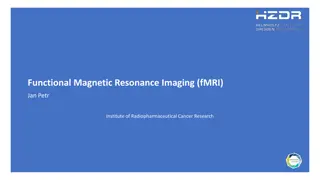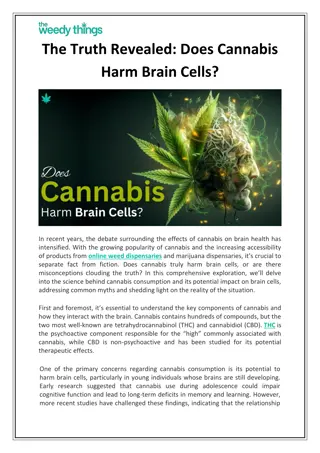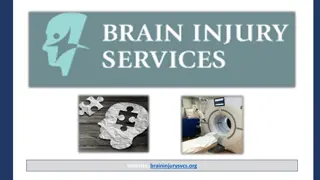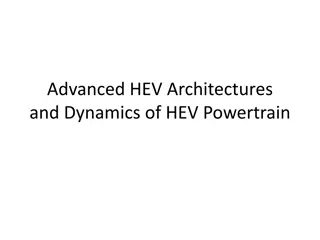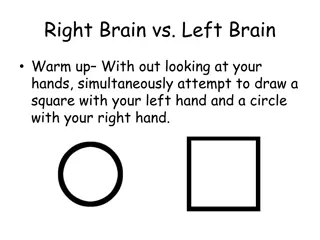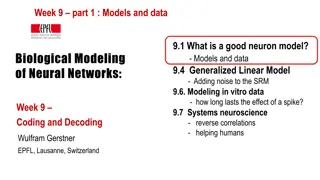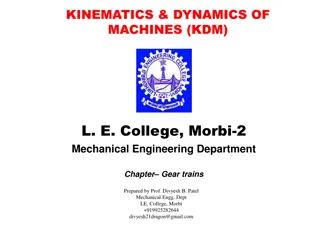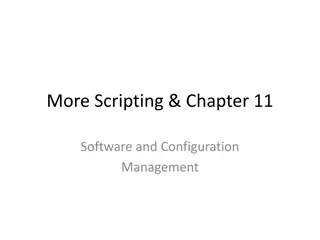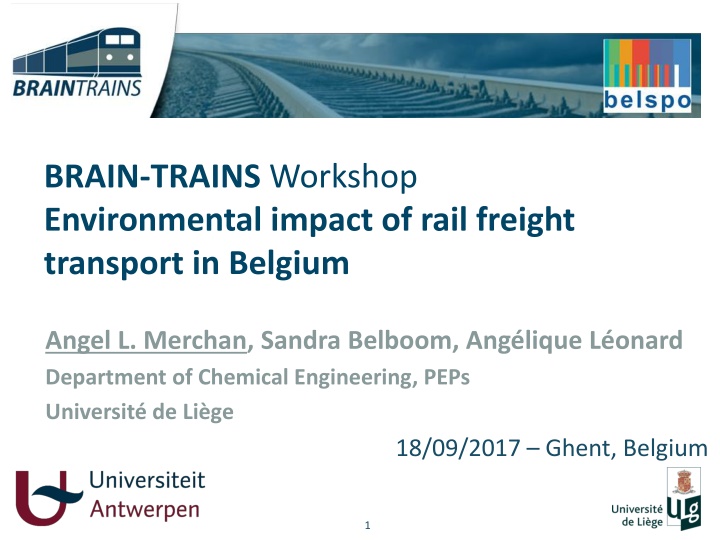
Environmental Impact of Rail Freight Transport in Belgium
This study explores the environmental impact of rail freight transport in Belgium through Life Cycle Assessment (LCA), focusing on areas such as raw material extraction, manufacturing, and end-of-life disposal. It analyzes energy consumption, electricity, and diesel usage in rail operations, comparing electric and diesel trains. The LCA results highlight the importance of sustainable practices in inland freight transport to mitigate climate change and other environmental risks.
Download Presentation

Please find below an Image/Link to download the presentation.
The content on the website is provided AS IS for your information and personal use only. It may not be sold, licensed, or shared on other websites without obtaining consent from the author. If you encounter any issues during the download, it is possible that the publisher has removed the file from their server.
You are allowed to download the files provided on this website for personal or commercial use, subject to the condition that they are used lawfully. All files are the property of their respective owners.
The content on the website is provided AS IS for your information and personal use only. It may not be sold, licensed, or shared on other websites without obtaining consent from the author.
E N D
Presentation Transcript
BRAIN-TRAINS Workshop Environmental impact of rail freight transport in Belgium Angel L. Merchan, Sandra Belboom, Ang lique L onard Department of Chemical Engineering, PEPs Universit de Li ge 18/09/2017 Ghent, Belgium 1
Life Cycle Assessment (LCA) Environmental impacts of a product from raw material extraction, through materials use, and finally to disposal 1 2 3 Material production Raw materials extraction Manufacturing Landfill End-of-life Use 2
Life Cycle Assessment (LCA) 1 Area of Protection Inventory Midpoints Endpoints 2 Climate change 3 Ozone depletion Damage to human health Human Health Human toxicity, non-cancer effects CO2, CO, CH4, NOX, SO2, PM10, dioxins land use and other resource flows Human toxicity, cancer effects Particulate matter Ionizing radiation Human Health Ionizing radiation Ecosystems Damage to ecosystem diversity Photochemical ozone formation Natural Environment Acidification Terrestrial eutrophication Freshwater eutrophication Marine eutrophication Freshwater ecotoxicity Resource scarcity Natural Resources Land use Water resource depletion Inland freight transport Resource depletion 3
LCA of inland freight transport Production Raw materials End-of-life Electricity Diesel Manufacturing Construction Maintenance Maintenance Rail Infrastructure Rail equipment Rail infrastructure Rail equipment Rail transport operation 17.5% Energy consumption of rail freight transport in Belgium (kJ/tkm) 1000 Year 2012 24.2% 58.3% 800 530 Road transport operation Inland Waterways transport operation 600 417 400 456 200 0 2005 2006 2007 2008 2009 2010 2011 2012 2014 Rail transport (Belgian traction mix) {BRAINTRAINS} Electric trains {BRAINTRAINS} Diesel trains (including shunting activity) {BRAINTRAINS} Electric trains {EcoTransIT} Diesel trains {EcoTransIT} Rail transport (Belgian traction mix) {Ecoinvent v3} 4
Rail operation: Energy consumption To move 1 tkm of freight on rail in Belgium in 2012, both consumptions were needed: 368 kJ of electricity 89 kJ of diesel (including 29 kJ of shunting activity) 1 2 3 Final electricity and diesel consumption (kJ/tkm) 100% 600 86% 84% 83% 83% 78% 76% 76% 500 80% 61% 454 400 429 60% 413 400 380 334 271 260 368 365 300 40% 172 164 163 157 200 136 39% 126 98 89 20% 100 24% 24% 22% 17% 17% 16% 14% 0 0% 1990 2006 2007 2008 2009 2010 2011 2012 2014 Final electricity consumption {BRAINTRAINS} Final electricity consumption {Ecoinvent v3} Electric traction share (%) Final diesel consumption {BRAINTRAINS} Final diesel consumption {Ecoinvent v3} Diesel traction share (%) 5
LCIA of rail freight transport in Belgium in 2012 100% 1 90% 80% 2 70% 60% 50% 3 40% 30% 20% 10% 0% Rail transport (Belgian traction mix) {BRAINTRAINS} Rail transport (Belgian traction mix) {Ecoinvent} Diesel trains (incl. shunting activity) {BRAINTRAINS} Electric trains {BRAINTRAINS} Max. in 4 indicators Max. in 10 indicators 6
LCA of inland freight transport Production Raw materials End-of-life Electricity Diesel Manufacturing Construction Maintenance Maintenance Rail Infrastructure Rail equipment Rail infrastructure Rail equipment Rail transport operation 17.5% End-of-life End-of-life Year 2012 24.2% 58.3% Road transport operation Inland Waterways transport operation Diesel Gas-oil Production Production Euro I-VI Canal Port facilities Rigid <7.5 t Rigid 28 - 32 t Road IW Infrastructure Rigid 7.5 - 12 t Rigid >32 t Rigid 12 - 14 t Art.14 - 20 t Manufacturing Maintenance Manufacturing Maintenance Lorry Barge Rigid 14 - 20 t Art. 20 - 28 t Rigid 20 - 26 t Art. 28 - 34 t Rigid 26 - 28 t Art. 34 - 40 t 7
Road freight transport in Belgium 1 Weight category "Articulated 34-40 t represents 75% of the HDT (tkm) every year in Belgium 2 3 Distribution of tkm in the road freight transport in Belgium EURO IV Art. 34 - 40 t Euro V Art. 34 - 40 t Euro IV Art. 34 - 40 t Euro III Art. 34 - 40 t Euro II Art. 34 - 40 t Euro I Art. 34 - 40 t Cnv. Arti. 28 - 34 t Euro V Arti. 28 - 34 t Euro IV Arti. 28 - 34 t Euro III Arti. 28 - 34 t Euro II Arti. 28 - 34 t Euro I Arti. 28 - 34 t Cnv. Art. 20 - 28 t Euro V Art. 20 - 28 t Euro IV Art. 20 - 28 t Euro III Art. 20 - 28 t Euro II Art. 20 - 28 t Euro I Art. 20 - 28 t Cnv. Art. 14 - 20 t Euro V Art. 14 - 20 t Euro IV Art. 14 - 20 t Euro III Art. 14 - 20 t Euro II Art. 14 - 20 t Euro I Art. 14 - 20 t Cnv. Rigid >32 t Euro V Rigid >32 t Euro IV Rigid >32 t Euro III Rigid >32 t Euro II Rigid >32 t Euro I Rigid >32 t Cnv. EURO V 100% 6% 7% 12% 14% 90% 21% 28% 19% 80% 26% 18% 23% 70% 21% 20% 20% 18% 60% 18% 17% 50% 15% 14% 8% 13% 8% 7% 40% 6% 6% 5% 18% 16% 14% 30% 13% 11% 10% 20% 10% 0% 2005 2006 2007 2008 2009 2010 8
Freight transport: energy consumption 1 Energy consumption (kJ/tkm) of inland freight transport modes Energy consumption (kJ/tkm) of inland freight transport modes 1200 1200 2 1000 1000 3 800 800 (kJ/tkm) (kJ/tkm) 600 600 400 400 200 200 0 0 2005 2005 2006 2006 2007 2007 2008 2008 2009 2009 2010 2010 2011 2011 2012 2012 Ecoinvent v3 2014 v3 2014 Ecoinvent EcoTransIT 2005 2005 EcoTransIT Rail transport (Belgian traction mix) Rail transport (Belgian traction mix) Diesel trains Diesel trains Electric trains Electric trains Inland waterways transport Inland waterways transport Road transport lorry art. 34-40 t (LF 50%) Road transport lorry art. 34-40 t (LF 50%) Road transport lorry art. 34-40 t (LF 60%) Road transport lorry art. 34-40 t (LF 60%) Road transport lorry art. 34-40 t (LF 85%) Road transport lorry art. 34-40 t (LF 85%) 9
LCIA of 1tkm of freight transport in Belgium in 2010 100% 1 90% 80% 2 70% 60% 50% 3 40% 30% 20% 10% 0% Diesel trains (incl. shunting activity) {BRAINTRAINS} Electric trains {BRAINTRAINS} Inland waterways transport {BRAINTRAINS} Road transport lorry art. 34 - 40 t (LF 50%) {BRAINTRAINS} Road transport lorry art. 34 - 40 t (LF 60% Euro VI) {BRAINTRAINS} Road transport lorry art. 34 - 40 t (LF 85% Euro VI) {BRAINTRAINS} Max. in 3 indicators Max. in 1 indicators Max. in 8 indicators Max. in 2 indicators 10 10
LCA of intermodal freight transport in Belgium 1 2 Main haulage by rail or road 3 Terminal Container Athus Port of Antwerp Intermodal terminal Post-haulage by road Main haulage Main haulage Main haulage Main haulage Main haulage by train by train by train by train by train Main haulage by road 14.3 t/TEU 14.3 t/TEU 16 560 16 560 16 560 16 560 Main haulage by road by road 14.3 t/TEU 14.3 t/TEU 14.3 t/TEU Main haulage Main haulage by road by road Main haulage Port of Antwerp Terminal Container Athus Port of Antwerp Terminal Container Athus Port of Antwerp Terminal Container Athus Port of Antwerp Terminal Container Athus Port of Antwerp Terminal Container Athus Average gross weight TEU (2.3 t container + 12 t load) Average gross weight TEU (2.3 t container + 12 t load) Average gross weight TEU (2.3 t container + 12 t load) Average gross weight TEU (2.3 t container + 12 t load) Average gross weight TEU (2.3 t container + 12 t load) 1. Transhipment in the Port of Antwerp (kJ/TEU)1 1. Transhipment in the Port of Antwerp (kJ/TEU)1 1. Transhipment in the Port of Antwerp (kJ/TEU)1 1. Transhipment in the Port of Antwerp (kJ/TEU)1 Load factor Average capacity Distance (km) Distance (km) Transport performance (tkm) Electricity (kJ/TEU) Load factor Average capacity Distance (km) Transport performance (tkm) Transport performance (tkm) Electricity (kJ/TEU) Diesel (MJ/TEU) Diesel (MJ/TEU) Load factor Average capacity Distance (km) Transport performance (tkm) 75% 75% 75% 85% 85% 85% Load factor Average capacity 70 TEU/train 307 231 441 231 441 231 441 70 TEU/train 307 307 2 TEU/lorry 245 245 2 TEU/lorry 245 209 327 209 327 209 327 70 TEU/train 2 TEU/lorry 2. Main haulage 2. Main haulage 2. Main haulage 3. Transhipment in Terminal Container Athus Container Athus 5 204 45.35 45.35 60% 3. Transhipment in Terminal 5 204 2 TEU/lorry 50 30 155 4. Post-haulage by road 11 1Messagie et al. (2014); 2Janic (2008)
LCIA of intermodal route Port of Antwerp - TCA 100% 1 90% 80% 2 70% 3 60% 50% 40% 30% 20% 10% 0% Diesel train Electric train Lorry art. 34 - 40 t Euro VI Max. in 6 indicators Max. in 4 indicators Max. in 4 indicators 12
Conclusion Intermodal electric rail freight transport represents an opportunity to attain a more environmentally and energy-efficient transport system 1 2 Difference of environmental impact compared to lorry 24-40 t Euro VI Electric train -29% -36% -1% +43% -48% +79% +43% -34% -26% -20% +35% -53% -75% -43% 3 Impact category Diesel train -9% -27% +2% +43% -17% -6% -18% +42% +37% +60% +20% -52% -65% -40% Climate change Ozone depletion Human Toxicity, non-cancer effects Human Toxicity, cancer effects Particulate matter Ionizing radiation HH Ionizing radiation E (interim) Photochemical ozone formation Acidification Terrestrial eutrophication Freshwater eutrophication Freshwater ecotoxicity Land use Resource depletion 13
Thank you for your attention. BRAIN-TRAINS BELSPO project Questions? 18/09/2017 Ghent, Belgium 14





